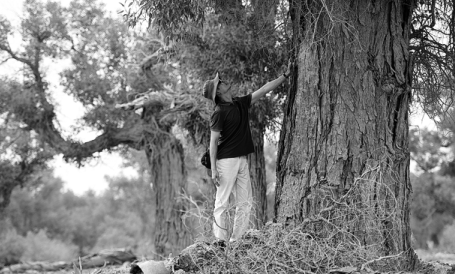Desert sentinels stand witness to shifting sands of time

In Aksu prefecture of Northwest China's Xinjiang Uygur autonomous region, about 30 kilometers from the northern edge of the desolate Taklimakan Desert, lies some of the oldest, most resilient trees in the world.
The desert poplars, spread over more than 200,000 hectares, are known to date back millennia. They stand silently amid the arid environment, their deep roots waiting patiently to draw waters from the Tarim River-a mighty waterway that helps sustain flourishing oases in the river basin and famous since ancient times for changing its course, to the detriment of many explorers and trade caravans of the old Silk Road navigating the harsh desert dunes.
The timeless, rugged beauty of the poplar forest enjoys legendary status among the area's ethnic communities, similarly becoming a major scenic spot for visitors home and abroad in recent years.
Interestingly, many artists and artisans have also been looking for inspiration among the trees. Through their masterly hands, the branches, bark and roots shed and left by the poplars become painting, sculpture, ornaments and other works of art that help draw even more tourists to the site.
Aware of the growing attraction, local authorities have been working with their communities toward the sustainable development of tourist sites.
The Tarim is one of the country's longest inland rivers, with a mainstream overall length of more than 1,320 km. Just four decades ago, intense irrigation caused about 400 km of its lower reaches to run dry, threatening the surrounding trees with extinction.
Thankfully, in the past two decades, more than 10 billion yuan ($1.55 billion) has been used toward the protection of the lower Tarim area ecosystem, with a national nature reserve covering large swathes of the forests in the river basin.
The river has since been diverted to flow across the desert poplar forests as part of an ongoing ecological restoration drive, with about 10 million cubic meters of water nourishing the trees in a five-year period.
The green gains have been encouraging, with the area recording significant increases in flora and fauna and biodiversity levels nearly doubling in the river's downstream area by the end of last year since the project began in 2016, figures from the Chinese Academy of Sciences show.
Environmental measures have also helped restore or improve at least 2,285 square km of vegetation along the Tarim's lower reaches, with areas hit by desertification reduced by more than 850 square km.
Near the Aksu poplar site, efforts are also being made to raise awareness and appreciation of the area's green legacy. River cruises point to the growing populations of plants and animals, while tourist food and lodging options run by local residents aim to make minimal impact on their natural neighbors through sustainable practices.
A cooperative of nearby villages, involving a total investment of more than 6 million yuan, is recording healthy returns, with peak visitor arrivals expected to hit 1,000 a day during the fall holiday season.
The poplars then are set to turn a rich, golden hue.


Today's Top News
- ‘Zero-tariff’ a blow to zero-sum game
- China's railways hit record 2.24 billion passenger trips in H1
- Collection of Xi's articles on education, other two books published in Hong Kong
- Local govts urged to improve handling of hot spot issues
- China hailed as stabilizing global force
- BRICS currency creates dilemma for the dollar





























